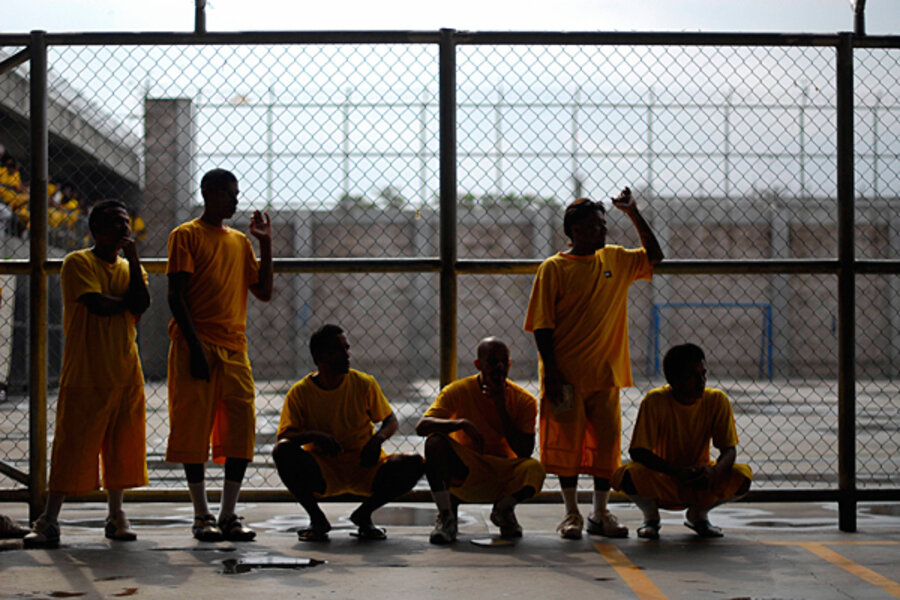Building on success: How El Salvador is trying to keep gang violence down
Loading...
• A version of this post ran on the author's site, Insightcrime.com. The views expressed are the author's own.
After a truce between warring gangs cut murders in El Salvador by half last month, the government is moving to consolidate its security gains through work opportunities for ex-gang members – but this will prove more difficult than brokering the peace deal.
Last week, El Salvador’s government announced a new scheme that it says will give tens of thousands of former gang members the opportunity to rejoin the labor market after they leave prison (link in Spanish). Vice Security Minister Douglas Moreno said that participants would receive job training and opportunities with companies participating in the project. The so-called “labor parks” would also be for "at risk" youth, who live in areas with high gang presence. The pilot scheme, the minister said, would have some 500 participants, but would eventually benefit between 50,000 and 70,000 people across the country (link in Spanish).
When announcing the initiative, the minister was flanked by representatives of Rio Grande, a preserved food company, and League Central America, a textiles producer. Both organizations have already launched schemes to employ former gang members, which have been running for some three years (link in Spanish). League Central America has 30 ex-gang members on its staff, making up 15 percent of its employees, while Rio Grande has 250, with another 100 currently taking part in rehabilitation workshops. Rodrigo Bolaños of the League urged other companies to take part, saying that "the gang members have shown us that they are productive."
These plans could be key to making recent dramatic security improvements last. The murder rate has plummeted since the country’s two biggest gangs, the Mara Salvatrucha (MS-13) and Barrio 18, declared a truce in early March, pledging to stop killing each others’ members, and attacking the security forces. Since the agreement, the murder rate has dropped below six murders a day, down from 13 murders a day in the first 10 weeks of the year.
[See InSight Crime's profiles of MS-13 and Barrio 18]
The first reports on the deal, by El Faro, said it was between the government and gangs. After a flurry of denials, the government later said it "facilitated" a truce between the gangs, offering no concessions, and that the Catholic Church brokered the accord. Now, as violence has dipped, the government seems to be taking more ownership of it, albeit admitting to its fragility. As Moreno points out, the truce is day-by-day, and needs business investment and employment for gang members to solidify its gains (link in Spanish).
“It’s volatile. A gang is an amorphous structure," he said. "[The truce] lasts 24 hours, after that you don’t know what is going to happen.”
What's more, the truce is limited in scope. While murder is down, extortion is increasing, with anonymous extortion demands up by 25 percent this year (link in Spanish). The negotiators of the truce are reportedly working to get the gang leaders to agree to cut extortion as well as murders, but this will be difficult to achieve if the gang members do not have alternative livelihoods. One of the main sources of income for Salvadoran gangs is extortion, with sophisticated networks managed from inside prisons by jailed gang members. Work schemes could help stop young people being recruited into gangs – some 13.3 percent of young people in the country are currently unemployed, with one in three classified as underemployed (in Spanish).
There are signs that the Funes government has the necessary commitment to make these rehabilitation and job creation programs work. Since he came to office in 2009, he has increased funding of prevention programs to 14 percent of the Security Ministry's budget, up from the previous average of around 1 percent, according to a Congressional Research Service report on the Central American Regional Security Initiative (CARSI).
However, there are serious practical obstacles standing in the way of the job-creation scheme. Any program to aid gang members comes with a heavy political cost, with many questioning why criminals should be given special help in a country where so many are poor.
Moreno also has said that the scheme will cost $20 million, though he failed to explain where this money would come from. One of the negotiators of the truce, a former congressman, suggested that funds to rehabilitate ex-gang members come out of subsidies that are currently paid to bus drivers. This angered many, with transport representatives pointing out that bus drivers had been amongst the most victimized by gang extortion (link in Spanish).
There is also the problem of finding companies willing to hire ex-convicts. Moreno said that companies that take on ex-gang members would get incentives from the government, though he did not give specifics. And on Friday, he admitted the government was having difficulty finding companies to take part in the program.
Schemes to get former gang members into work have been floated in El Salvador, and across the region, for at least a decade, but none have managed to make a dent in rates of crime and gang membership. The same Congressional Research Service report noted that "government-sponsored·prevention programs have tended, with some exceptions (such as Nicaragua’s national youth·crime prevention strategy), to be small-scale, ad hoc, and underfunded." It is not clear why this scheme would be any different, especially as the vice security minister has not been able to explain where the money will come from to fund it and who will participate in it.
– Hannah Stone is a writer for Insight – Organized Crime in the Americas, which provides research, analysis, and investigation of the criminal world throughout the region. Find all of her research here.
Get daily or weekly updates from CSMonitor.com delivered to your inbox. Sign up today.





